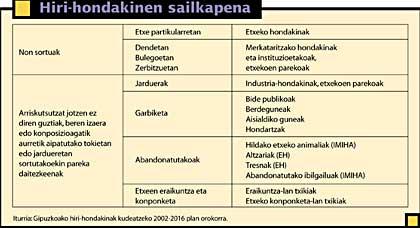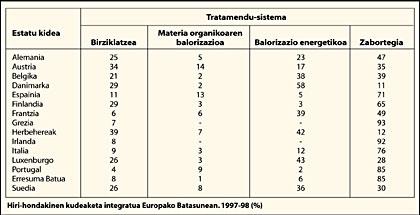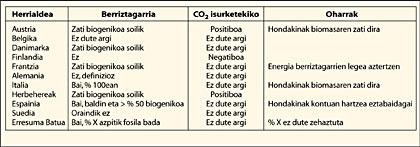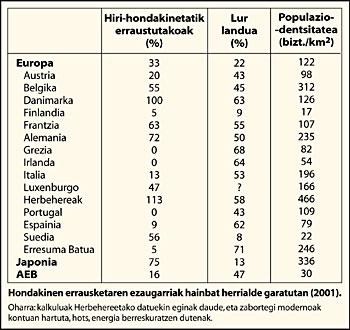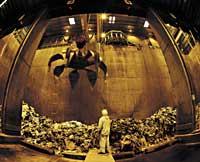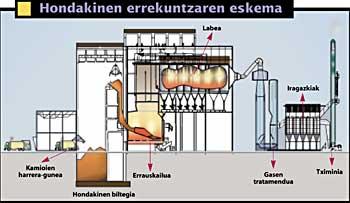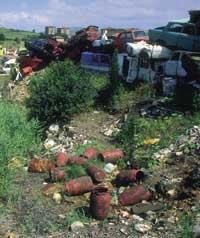Garbage, garbage
2004/10/01 Imaz Amiano, Eneko - Elhuyar Zientziaren Komunikazioa Iturria: Elhuyar aldizkaria
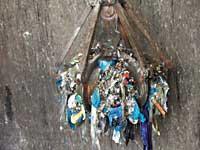
The data are not the same from the province to the province, but it can be said that each of us each day generate more than one kilo; more than 1.5 kilos the vizcaínos and guipuzcoanos. We are at the head of the most advanced states in Europe.
Several reasons are mentioned for the generation of this amount of waste, but in general they can be associated with Western life. The examples are many, but, to name a few, they no longer collect glass bottles in stores, but they collected them and returned the money. Or how many packaging do some products have? Boxes of 12 products wrapped in plastic and products inside the box, in turn, isolated or paired in plastic.
These are things that somehow ‘impose’ us from the outside. And in many cases you can not buy or buy. Other times, for example, in the case of glass containers and tetra-briks, the price difference is usually very high, to the detriment of glass.
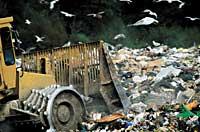
But our behavior also influences. For example, today there are few people who look on the street with cloth scarves, although it is not much work and expense to get into the washing machine along with the rest of the clothes. Therefore, to some extent it is in our hands to generate more or less garbage.
So far
Until the late 1970s garbage was poured everywhere. Municipal collection systems collected the trash and took it to landfills without control or monitoring. In addition, many of the wastes did not even reach the collection systems, each one threw them out the window to the river or the moat next to the hamlet and burned.
However, in the 1980s, institutions began to control the situation. Containers for selective garbage separation also appeared on the streets and people stopped throwing garbage bags anywhere, regardless of the bagless garbage from the roadside and leisure areas. Small incinerators such as Arrasate, Aulestia or Baztan were also created.
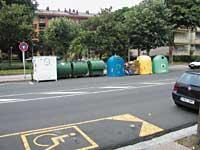
In the 1990s, the laws of one another worsened, especially driven by Europe. These small, poorly controlled incinerators were closed. On the other hand, several biogas harvesting plants were made in various landfills, which collect the methane generated by rotting organic matter from the garbage and obtain electrical energy. The Montejurra Commonwealth promoted selective collection and composting, managing to recycle more than 60% of the waste. And in Legazpi the composting plant was also launched. However, most of the waste remains deposited in landfills.
From now on
However, the European Union has already welcomed landfills. The controls are very strict and only those waste that cannot be subjected to any other action can be brought to the landfills. That is, only what cannot be recycled, reused, compostar or valued in any way.

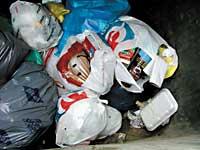
Given this, provincial institutions have opted for different ways. In Iparralde, landfills and incineration have been used so far, but the incinerator of Baiona is very old and is scheduled to close in 2009, since it does not meet the new standards. The managing entity of most of the Northern garbage, Bil and Garbi, will decide in November which of the four projects it has on the table, but in three of them would take advantage of the incinerators, two to the North of the incinerator and the third of the Txingudi commonwealth. Currently they recycle 12% of waste and in the coming years they want to increase the percentage to 21%.
In Navarre the main lines are the reduction in waste generation, selective collection and treatment, recycling, composting, recovery and remarketing of inorganic substances and the deposition of the rest in landfills. In 2005, the objective of reusing and recycling 65% of urban solid waste has been set, as well as adapting landfills to European regulations. Containers will also be placed for organic matter that collect 95% of what is generated and subsequently compost. No incinerators are mentioned in the plan. The comprehensive waste management plan 1999-2003, in force indefinitely, provides for a total investment of almost 80 million?
In Alava the Plan was developed for the period 1998-2001 and the new one is currently being studied. The main objective of this plan was the installation of container collection, whose philosophy seems to be the selective collection and treatment of waste. It is estimated that the entry into force of the Plan would cost almost 9 million? In addition, in the future it is expected to study and implement composting with organic matter. We must take into account the importance of agriculture in Alava and therefore the high generation of organic waste, as well as the high consumption of compost.
As for Gipuzkoa, the debate is being tough. On the one hand, the Commonwealth of Txingudi had agreed to build the incinerator. Several groups of citizens confronted and held discussions with the Council. However, his has finally been achieved and the process continues. On the other hand, the Provincial Council began working on the plan for Gipuzkoa and analyzed seven alternatives grouped into three groups, always taking into account the incineration of one degree or another. Finally it has opted for the third group of alternatives and, in addition to that of Txingudi, the Council has decided to build a new incinerator in Donostia.
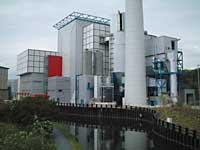
These infrastructures would incinerate 59% of Gipuzkoa's urban waste in 2016. The rest, on the other hand, would become compost 4%, which currently is around 1%, and recycle 37% compared to the current 14.4%. For this purpose they plan to make a special effort in the selective collection. Currently 84% of the waste is taken to landfill without treatment, and in 2016 only 4% would be taken, that is, ashes and waste that will not receive any other treatment. Total 143 and 164 million ? A joint investment is expected.
Finally, in Bizkaia the project was developed for the period 1997-2001, under which they have worked. The second phase is now being drafted, 2002-2007, which will be subsequently approved. In Bizkaia the main criteria are the reduction of the amount of waste, recycling and valorization. And for this assessment the incinerator of Zabalgarbi has been launched recently.
The programme balance for the period 1997-2001 reflects that total waste generation has been much lower than expected for 2001, although domestic waste has grown 8.44% more than expected. In addition, they have recycled less than expected, since the goal was to recycle more than a third of the waste and have not managed to recycle a quarter.
In the second phase of the Plan, the following objectives are being studied for 2007: 47% recycling of urban solid waste, 32% landfill deposit, 18% valorization by incinerator, 2% composting and 1% valorization by gasification. For these purposes the construction of new incinerators in the provisional project is not foreseen. A budget of 44 million is estimated. However, the second phase is still pending approval.
Therefore, each territory has analyzed the problem and tried to solve it. The result will be seen in the coming years.
And out of here?
The trend of the European Union seems favorable to incineration. However, it is difficult to summarize the situation and trends of each country. For this reason, we have taken data or fragments of texts from reports from different institutions, favorable and unfavorable.
The General Plan for Urban Waste Management of Gipuzkoa 2002-2016 “The European Union’s strategy is to prevent – reduction of waste production and reuse of waste – the valorization of matter – recycling and composting – energy recovery and, finally, the disposal of non-valorizable waste – landfill deposit. However, it also allows the treatment of organic matter through biological mechanical treatment and its landfill deposit.”
“The countries that base their management on landfills (…) are the ones that recycle the least” “The countries that use energy recovery in a significant percentage of incineration (20%) or in a very high amount (35%) are the ones that recycle the most, except for France. (20%).”
European Parliament and of the Council on the promotion of electricity from renewable energy sources in the internal electricity market. COM (2000) 279 final 2000/0116(COD)
“1. Article: The objective of this Directive is to unify criteria for increasing the contribution of renewable sources of electricity production in the internal electricity market.
Article 2: For the purposes of the Directive the definitions of Directive 96/92/EC shall be used. And also: 1.- “renewable energy sources” will be renewable sources of non-fossil origin (wind, sun,…) and biomass, that is, agroforestry products, plant residues of the agroforestry and food industry, waste of untreated wood and cork residues”.
A Study on the Econimic Valuation of the Environmental Externalities from Landfill Disposal and Incineration of Waste. Final Main Report-2000. European Commission, DG Environment
“Net energy recovered by incineration reduces the environmental impact attributable to energy from conventional sources. Reduced impacts include those attributed to atmospheric emissions, saved fossil fuels and waste from conventional energy production.”
Waste as a Renewable Source of Energy: Current and Future Practices. IMECE2003-55258
“Urban solid waste has been declared in several States as renewable energy sources.”
Governmental support to Waste-to-Energy. ISWA Beacon Conference, Malmö 2003.
“But waste-to-energy (WTE) is also higher. Landfill gas is also an important source of energy.” “As for renewable energy policies, global urban waste incineration (WTE) is the most interesting valuation.”
Burn or Bury? A Social Cost Comparison of Final Waste Disposal Methods. Nota di Lavoro 46.2003
“It is widespread to think that waste incineration and, in particular, access to waste energy (WTE) is mainly due to soil scarcity in several countries. As seen in the table, however, there is no direct relationship between incineration of urban waste and the percentage of population density and worked territory.”
“Our analysis raises doubts about priority policies against incineration. Taking into account the private and environmental costs, it is observed that the alternative of landfills is cheaper than that of incineration. In addition to recovery efforts, incineration is cheaper only in the area of dumping in the medium.”
Waste of Resources? WWF
“Instead of replacing energy from coal and other fossil fuels, energy from waste will replace energy from real energies.”
Waste Working Group; Ireland
“For example, the German packaging ordinance has eliminated the second packaging of certain products. They have realized that 98% of the second wrappings – box to collect the tube from the toothpaste, plastic to wrap the boxes of ice cream… – are not necessary. It is also very easy to reduce by 20-50% most industrial packaging and many food.”

Gai honi buruzko eduki gehiago
Elhuyarrek garatutako teknologia




